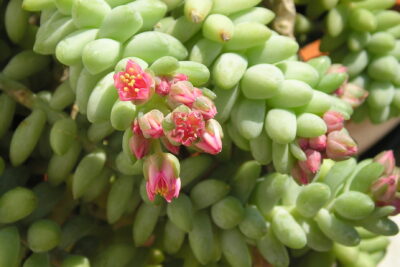
Succulent Flowers: A Complete Guide to Blooming Beauty

Succulent flowers are a captivating addition to any garden or indoor space. These unique plants have thick, fleshy leaves and stems that store water, making them incredibly resilient and low-maintenance. While succulents are often admired for their striking foliage, many varieties also produce stunning flowers that add a burst of color and beauty to their already unique appearance.
We will explore the world of succulent flowers, providing you with a complete guide to their care and cultivation. We will discuss the different types of succulents that produce flowers, their preferred growing conditions, and tips for promoting healthy blooms. Additionally, we will delve into the various colors, shapes, and sizes of succulent flowers, showcasing some of the most popular and sought-after varieties. Whether you are a seasoned succulent enthusiast or a beginner looking to add some blooming beauty to your space, this article will equip you with the knowledge and inspiration you need to successfully grow and enjoy succulent flowers.
- Choose succulent plant varieties that are known for their beautiful blooms
- Provide adequate sunlight for your succulent flowers to thrive
- Use well-draining soil to prevent root rot and promote healthy growth
- Water your succulent flowers sparingly to prevent overwatering
- Fertilize your succulent flowers with a balanced plant food to encourage blooming
- Keep an eye out for pests and treat them promptly to protect your succulent flowers
- Prune your succulent flowers to maintain their shape and promote new growth
- Be patient, as succulent flowers may take some time to bloom
- Enjoy the unique and stunning beauty of your succulent flowers as they bloom
- Frequently Asked Questions
Choose succulent plant varieties that are known for their beautiful blooms
When it comes to succulent flowers, there are several plant varieties that are known for their stunning blooms. These succulents not only offer unique and interesting foliage but also produce vibrant and eye-catching flowers that can add a touch of beauty to any garden or indoor space.
One popular succulent known for its beautiful blooms is the Echeveria. With its rosette-shaped leaves and tall flower stalks, Echeveria plants produce clusters of colorful, bell-shaped flowers that range in shades of pink, red, orange, and yellow. These flowers not only attract attention but also provide a delightful fragrance.
Another succulent that is loved for its exquisite blooms is the Kalanchoe. This plant features thick, fleshy leaves and produces small, vibrant flowers in hues of red, pink, orange, and yellow. The flowers are often arranged in clusters, creating a striking display of color.
Aloe plants are also known for their unique and beautiful blooms. While most people are familiar with Aloe for its medicinal properties, the plant also produces long, tubular flowers in shades of red, orange, and yellow. These flowers attract pollinators and add a touch of elegance to any succulent garden.
 The Rare Succulent: Uncovering Its Unique Qualities
The Rare Succulent: Uncovering Its Unique QualitiesFor those looking for a succulent with larger and showier blooms, the Desert Rose is an excellent choice. This succulent produces large, trumpet-shaped flowers in vibrant shades of pink, white, and red. The flowers can reach up to 3 inches in diameter, creating a mesmerizing display of color and beauty.
When selecting succulent plants for their blooms, it's important to consider their specific care requirements. While most succulents are known for their resilience and ability to thrive in various conditions, each variety has its own preferences for sunlight, water, and soil. It's essential to provide the right growing conditions to ensure optimal flower production and overall plant health.
Succulent flowers offer a unique and captivating beauty that can enhance any garden or indoor space. By choosing succulent plant varieties known for their blooms, such as Echeveria, Kalanchoe, Aloe, and Desert Rose, you can enjoy not only the fascinating foliage but also the stunning flowers they produce. Remember to provide the appropriate care for each plant to ensure a successful and vibrant display of succulent blooms.
Provide adequate sunlight for your succulent flowers to thrive
Why sunlight is crucial for succulent flowers
Succulent flowers are known for their ability to store water in their leaves, stems, or roots. This adaptation allows them to survive in arid conditions. However, to encourage blooming beauty in your succulent flowers, providing adequate sunlight is essential.
Strong sunlight is necessary for succulents to undergo photosynthesis, the process by which they convert sunlight into energy. This energy fuels their growth and flowering process.
How much sunlight do succulent flowers need?
Succulent flowers typically require at least 6 hours of direct sunlight each day. However, it's important to note that different succulent species have varying sunlight requirements, so it's crucial to research the specific needs of your succulent flowers.
 Best Sun-loving Succulents for Tokyo: Top Choices & Tips
Best Sun-loving Succulents for Tokyo: Top Choices & TipsBest practices for sun exposure
- Positioning: Place your succulent flowers in a location that receives ample sunlight. South-facing windows or outdoor areas with unobstructed sunlight are ideal.
- Rotate: To ensure even growth and prevent your succulent flowers from leaning towards the light source, rotate them every few weeks.
- Protection: While succulent flowers thrive in sunlight, intense heat can be damaging. If your region experiences scorching temperatures, provide some shade or move your succulent flowers to a slightly cooler location during the hottest parts of the day.
Signs of inadequate sunlight
If your succulent flowers are not receiving enough sunlight, they may exhibit the following symptoms:
- Pale or stretched out leaves
- Lack of flowering or stunted growth
- Leaning towards the light source
Should you notice any of these signs, it's crucial to adjust their sun exposure accordingly to ensure their optimal health and blooming beauty.
Use well-draining soil to prevent root rot and promote healthy growth
One of the most important factors for successfully growing succulent flowers is to provide them with the right type of soil. Succulents have adapted to thrive in arid conditions, so they prefer soil that drains well and doesn't hold excess moisture. Using well-draining soil is crucial to prevent root rot, which can be fatal for these plants.
When choosing soil for your succulent flowers, opt for a sandy or gritty mix that allows water to flow through easily. You can create your own well-draining soil by combining equal parts of regular potting soil, perlite, and coarse sand. This mixture will provide the perfect balance of moisture retention and good drainage.
It's also important to use a pot with drainage holes to ensure excess water can escape and prevent waterlogged soil. This will further help to prevent root rot and keep your succulent flowers healthy and happy.
Tips:
 Large and Lush: Discover the Succulents that Grow to Impressive Sizes
Large and Lush: Discover the Succulents that Grow to Impressive Sizes- When repotting your succulent flowers, gently remove any excess soil from the roots to ensure they are not sitting in wet soil.
- Water your succulents only when the top inch of soil feels dry, and avoid overwatering.
- If you notice signs of root rot, such as mushy or discolored roots, take immediate action by removing the affected parts and repotting the plant in fresh, well-draining soil.
By using well-draining soil and following proper watering practices, you can provide your succulent flowers with the ideal growing conditions, promoting healthy growth and beautiful blooms.
Water your succulent flowers sparingly to prevent overwatering
When it comes to succulent flowers, one of the most important factors to consider is watering. These unique and beautiful plants have adapted to survive in arid environments, making them highly efficient at storing water. As a result, they don't need to be watered as frequently as other types of flowers.
It's crucial to water your succulent flowers sparingly to prevent overwatering. Overwatering can lead to root rot and other issues that may harm your plants. Remember, these flowers are designed to withstand drought-like conditions, so they can tolerate dry spells better than excessive moisture.
Here are some tips to help you navigate the watering needs of succulent flowers:
1. Observe the soil moisture
Before watering your succulent flowers, check the moisture level of the soil. Stick your finger about an inch into the soil – if it feels dry, it's time to water. If it's still moist, hold off on watering for a few more days.
2. Water deeply but infrequently
When watering your succulent flowers, it's important to give them a thorough soak. This encourages the roots to grow deeper, making the plants more resilient to drought. However, you should avoid frequent shallow watering, as this can lead to weak root systems.
3. Use well-draining soil
Succulent flowers require well-draining soil to prevent water from sitting around the roots and causing rot. Look for a specialized succulent potting mix or create your own by adding coarse sand or perlite to regular potting soil. This will ensure excess water flows away from the roots.
 Explore Unique and Stunning Succulent Plants with Striking Names
Explore Unique and Stunning Succulent Plants with Striking Names4. Adjust watering based on seasons
As with many plants, succulent flowers have different watering needs depending on the season. During the active growing season, which is typically spring and summer, they may require more frequent watering. However, in the dormant season, usually fall and winter, their water needs decrease significantly. Adjust your watering schedule accordingly.
By following these watering tips, you can help your succulent flowers thrive and bloom with vibrant beauty. Remember, moderation is key when it comes to watering these resilient plants.
Fertilize your succulent flowers with a balanced plant food to encourage blooming
Succulent flowers are known for their stunning beauty and unique ability to store water in their fleshy leaves. However, to ensure that your succulent flowers bloom to their full potential, it is crucial to provide them with the right nutrients. Fertilizing your succulent flowers with a balanced plant food is an effective way to promote healthy growth and encourage abundant blooming.
When choosing a plant food for your succulent flowers, opt for a well-balanced fertilizer that contains equal amounts of nitrogen, phosphorus, and potassium (N-P-K ratio of 10-10-10 or 20-20-20). This balanced ratio will provide your succulent flowers with the essential nutrients they need without causing excessive growth or damage.
It is important to note that succulent flowers have different nutritional needs compared to other flowering plants. Due to their water-storing abilities, succulents have adapted to survive in dry and arid environments with minimal nutrients. Therefore, they require a more diluted fertilizer solution and less frequent feeding compared to traditional flowering plants.
When fertilizing your succulent flowers, it is recommended to dilute the plant food to half or even a quarter of the recommended strength. This will prevent over-fertilization, which can lead to root burn and other issues. Remember, it is always better to under-fertilize than to over-fertilize your succulent flowers.
 Best Tall-Leafed Succulents for Indoor Thriving: A Guide
Best Tall-Leafed Succulents for Indoor Thriving: A GuideAdditionally, it is advisable to apply the diluted fertilizer solution sparingly. A little goes a long way with succulent flowers. Apply the fertilizer directly to the soil around the base of the plant, taking care not to get any on the leaves or stems. This will ensure that the nutrients are absorbed by the roots and distributed to all parts of the plant.
Feeding your succulent flowers with a balanced plant food during their active growing season, typically in spring and summer, will yield the best results. However, it is crucial to adjust the feeding schedule according to the specific needs of your succulent species. Some succulent flowers may require more frequent feeding, while others may thrive with less frequent fertilization.
Lastly, remember that proper watering and sunlight exposure are equally important factors for the blooming of your succulent flowers. Ensure that your succulents receive adequate sunlight and are watered according to their specific requirements. Combined with the right fertilizer, these care practices will help your succulent flowers bloom to their full potential, showcasing their mesmerizing beauty for all to admire.
Keep an eye out for pests and treat them promptly to protect your succulent flowers
Pests can be a common problem for succulent flowers, but with proper care and attention, you can easily treat and prevent them from damaging your plants. Here are some tips to keep an eye out for pests and treat them promptly to protect your succulent flowers:
1. Regularly inspect your plants
Make it a habit to regularly inspect your succulent flowers for any signs of pests. Look for tiny insects, webs, or sticky residue on the leaves or stems. Pests like aphids, mealybugs, and spider mites are common culprits that can infest succulent plants.
2. Remove pests manually
If you spot any pests on your succulent flowers, it's important to act quickly. Use a pair of tweezers or a cotton swab dipped in rubbing alcohol to manually remove the pests. Be careful not to damage the plant while doing so. Dispose of any pests you remove to prevent reinfestation.
 Discover the Must-Have Succulent Types for Your Collection
Discover the Must-Have Succulent Types for Your Collection3. Try natural remedies
For minor infestations, you can try using natural remedies to treat the pests. Neem oil, diluted dish soap, or a mixture of water and rubbing alcohol can be effective in controlling pests on succulent flowers. Apply these remedies to the affected areas and repeat the process as necessary.
4. Introduce beneficial insects
Consider introducing beneficial insects like ladybugs or predatory mites to your garden. These natural predators can help control pests by feeding on them. However, be cautious when introducing new insects to your succulent flowers, as some may also harm your plants.
5. Maintain a clean environment
Keeping your succulent flowers and their surroundings clean can help prevent pest infestations. Remove any fallen leaves, debris, or dead plant material from the vicinity of your plants. This reduces hiding spots and eliminates potential breeding grounds for pests.
Remember, prevention is key when it comes to protecting your succulent flowers from pests. Providing your plants with proper care, including adequate sunlight, well-draining soil, and appropriate watering, can help keep them healthy and less susceptible to pests.
By following these tips and promptly treating any pest infestations, you can ensure your succulent flowers bloom beautifully and thrive in a pest-free environment.
Prune your succulent flowers to maintain their shape and promote new growth
Succulent flowers are not only known for their stunning beauty, but also for their ability to thrive in various conditions. Pruning is an essential practice that can help you maintain the shape of your succulent flowers and encourage them to produce more blooms. Here are some tips to guide you in proper succulent flower pruning:
 Discover the Most Beautiful Succulents with White Flowers
Discover the Most Beautiful Succulents with White Flowers1. Timing is crucial
Pruning your succulent flowers at the right time is vital for their overall health and blooming potential. It is generally recommended to prune them during their active growing season, which is typically in spring or early summer. Avoid pruning during their dormant period as it may hinder their growth.
2. Use the right tools
When it comes to pruning succulent flowers, it is important to use the right tools to avoid damaging the plants. A pair of clean, sharp pruning shears or scissors is ideal for removing dead or overgrown parts. Make sure to disinfect your tools before and after use to prevent the spread of diseases.
3. Remove dead or damaged parts
Inspect your succulent flowers for any dead or damaged parts and carefully remove them. Dead leaves or stems not only affect the appearance of your plants but can also attract pests or diseases. Trim them off at the base using your pruning shears.
4. Shape your succulent flowers
If you notice that your succulent flowers have become leggy or unevenly shaped, pruning can help you achieve a more balanced appearance. Identify the areas that need shaping and carefully trim them back, keeping in mind the natural growth pattern of the plant.
5. Encourage new growth
Pruning stimulates new growth in succulent flowers. To encourage the development of more blooms, consider cutting back the spent flower stalks or removing the top portion of the stem. This process redirects the plant's energy towards producing new flowers.
6. Don't over-prune
While pruning is beneficial for succulent flowers, it is important not to overdo it. Avoid removing more than one-third of the plant's foliage at a time, as it may stress the plant and hinder its growth. Take a conservative approach and only remove what is necessary.
By incorporating proper pruning techniques into your succulent flower care routine, you can maintain their shape, promote new growth, and enjoy their blooming beauty for years to come.
 Explore Glowing Succulents: Nature's Enchanting Illumination
Explore Glowing Succulents: Nature's Enchanting IlluminationBe patient, as succulent flowers may take some time to bloom
Succulents are known for their unique and beautiful foliage, but did you know that many succulent varieties also produce stunning flowers? While succulent flowers can be a delightful surprise, it's important to remember that they may take some time to bloom.
Succulents are adapted to survive in harsh and arid environments, and their main goal is to store water in their fleshy leaves and stems. This means that the production of flowers is not their top priority. Instead, they focus on growing and storing enough energy to survive in their native habitats.
So, if you're eagerly waiting for your succulent to bloom, it's essential to be patient. Depending on the species and growing conditions, it can take anywhere from a few months to several years for your succulent to produce flowers.
However, don't let the wait discourage you! The beauty of succulent flowers is worth the patience. When they do bloom, you'll be rewarded with a burst of vibrant colors and intricate petal formations.
Factors that influence succulent flower blooming
Several factors can influence the blooming of succulent flowers. Understanding these factors can help you create the optimal conditions for your succulents to bloom:
- Light: Succulents require bright sunlight to thrive and bloom. Ensure that your succulents are placed in a location that receives at least six hours of direct sunlight per day.
- Temperature: Succulents are typically tolerant of a wide range of temperatures. However, some species may require specific temperature conditions to trigger flowering. Research the specific temperature preferences of your succulent variety.
- Watering: Overwatering can hinder the blooming process. Succulents prefer infrequent, deep watering rather than constant moisture. Allow the soil to dry out completely between watering sessions.
- Nutrition: Providing your succulents with a balanced fertilizer during their active growth period can promote flower production. Use a fertilizer specifically formulated for succulents and follow the instructions carefully.
By considering these factors and providing the right care, you can increase the chances of your succulents blooming. However, it's important to remember that each succulent is unique, and blooming is not guaranteed.
 Discovering Succulent Species with Large Leaves
Discovering Succulent Species with Large LeavesRemember, the journey to succulent flower blooming is just as rewarding as the end result. Enjoy the process of nurturing and caring for your succulents, and the anticipation of their eventual bloom. With patience and proper care, you'll be rewarded with the breathtaking beauty of succulent flowers.
Enjoy the unique and stunning beauty of your succulent flowers as they bloom
When it comes to adding a touch of natural beauty to your surroundings, succulent flowers are the perfect choice. With their unique and stunning appearance, these plants can effortlessly enhance any space they are in. Whether you are a seasoned gardener or just starting out, this complete guide will provide you with all the information you need to successfully grow and enjoy the blooming beauty of succulent flowers.
Understanding Succulent Flowers
Succulent flowers are a type of plant that store water in their leaves, stems, and roots. This ability to retain moisture allows them to thrive in arid climates and makes them an excellent choice for those with a busy lifestyle or limited gardening experience. Succulent flowers come in a wide range of shapes, sizes, and colors, making them a versatile and visually appealing addition to any garden or indoor space.
Choosing the Right Succulent Flowers
When selecting succulent flowers for your garden, it's important to consider factors such as the climate, sunlight exposure, and available space. Some popular choices for outdoor succulent flowers include Echeveria, Sedum, and Crassula. If you are looking to add some greenery to your indoor space, options like Haworthia, Aloe Vera, and Jade Plant are great choices. Remember to choose succulent flowers that suit your personal preferences and the specific conditions of your environment.
Caring for Succulent Flowers
One of the reasons why succulent flowers are so popular is because they are relatively low-maintenance plants. However, they still require some care to ensure they thrive and bloom beautifully. Here are some essential care tips for succulent flowers:
- Light: Most succulent flowers require bright, indirect sunlight. Place them near a window or in a well-lit area.
- Watering: Succulent flowers have water-storing capabilities, so be careful not to overwater them. Allow the soil to dry out between waterings.
- Soil: Use a well-draining soil mix specifically formulated for succulents to prevent waterlogged roots.
- Temperature: Succulent flowers generally prefer warmer temperatures but can tolerate mild cold. Protect them from frost or extreme heat.
- Fertilizing: Feed your succulent flowers with a balanced fertilizer formulated for cacti and succulents during the growing season.
Encouraging Blooming in Succulent Flowers
If you want your succulent flowers to bloom and showcase their beauty, there are some additional steps you can take:
 Are Succulents with Wavy Leaves a Rare and Unique Variety?
Are Succulents with Wavy Leaves a Rare and Unique Variety?- Provide Adequate Light: Ensure your succulent flowers receive enough sunlight, as it is crucial for blooming.
- Monitor Temperature: Maintain a consistent temperature range suitable for your succulent flowers to encourage blooming.
- Prune and Remove Dead Leaves: Regularly remove dead leaves and prune your succulent flowers to promote new growth and blooming.
- Reduce Watering: As succulent flowers approach their blooming period, reduce watering to mimic their natural conditions.
- Be Patient: Blooming in succulent flowers can take time, so be patient and enjoy the process of nurturing them.
By following these guidelines, you can ensure that your succulent flowers bloom beautifully and become a focal point in your garden or indoor space. Their unique and stunning beauty will bring joy and tranquility to your surroundings, making them a worthwhile addition to any plant collection.
Frequently Asked Questions
1. What are succulent flowers?
Succulent flowers are flowers that grow on plants that have thick, fleshy leaves and stems, which store water. These flowers are known for their unique beauty and resilience.
2. How do I care for succulent flowers?
To care for succulent flowers, provide them with well-draining soil, ample sunlight, and water sparingly. Avoid overwatering and ensure proper airflow around the plant to prevent rot.
3. Can succulent flowers be grown indoors?
Yes, succulent flowers can be grown indoors. Choose a sunny spot near a window and provide them with the right conditions, such as well-draining soil and proper watering, to thrive indoors.
4. Do succulent flowers require special fertilizers?
Succulent flowers generally do not require special fertilizers. However, you can use a balanced, diluted fertilizer during the growing season to promote healthy growth. Avoid over-fertilizing, as it can harm the plant.
If you want to read more articles similar to Succulent Flowers: A Complete Guide to Blooming Beauty, you can visit the Varieties and Colors category.






You Must Read